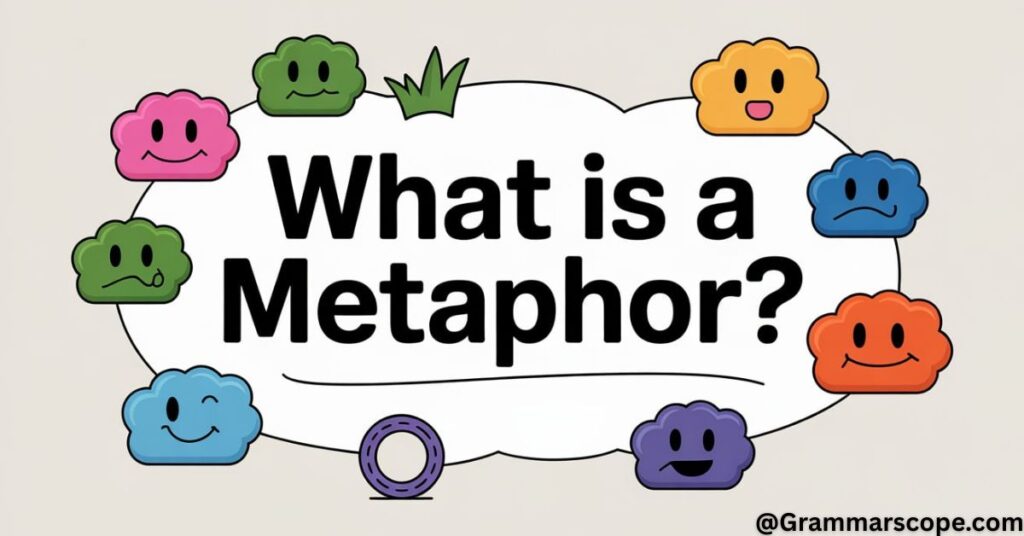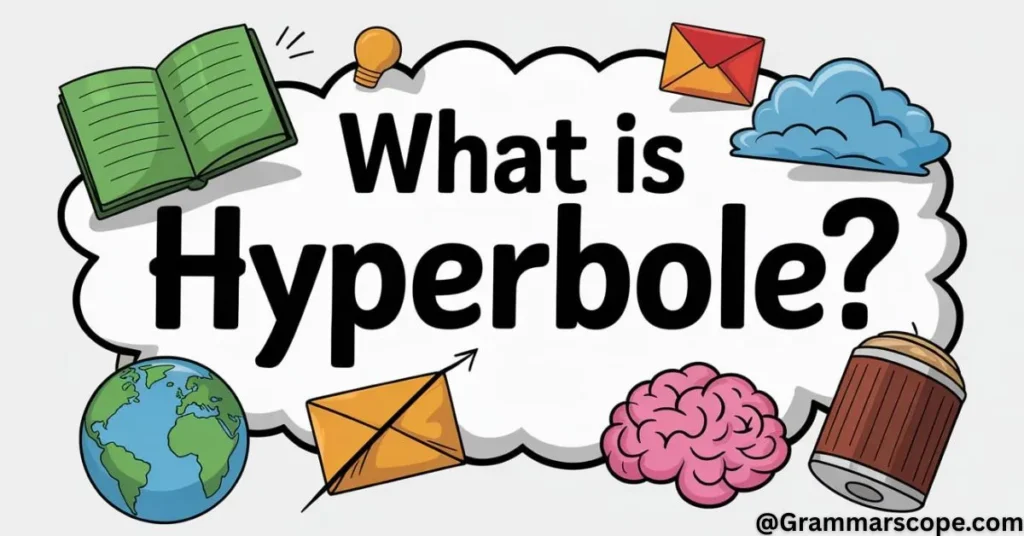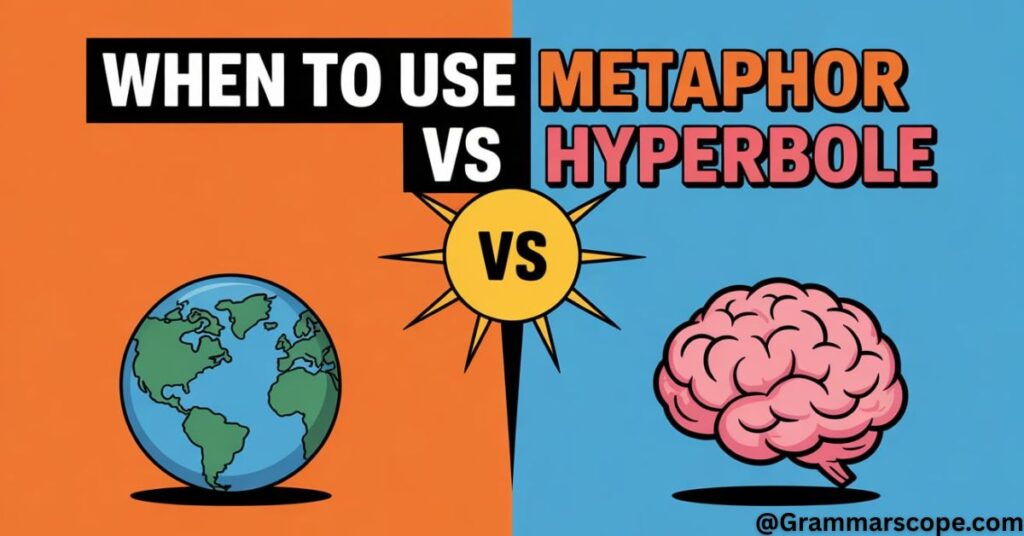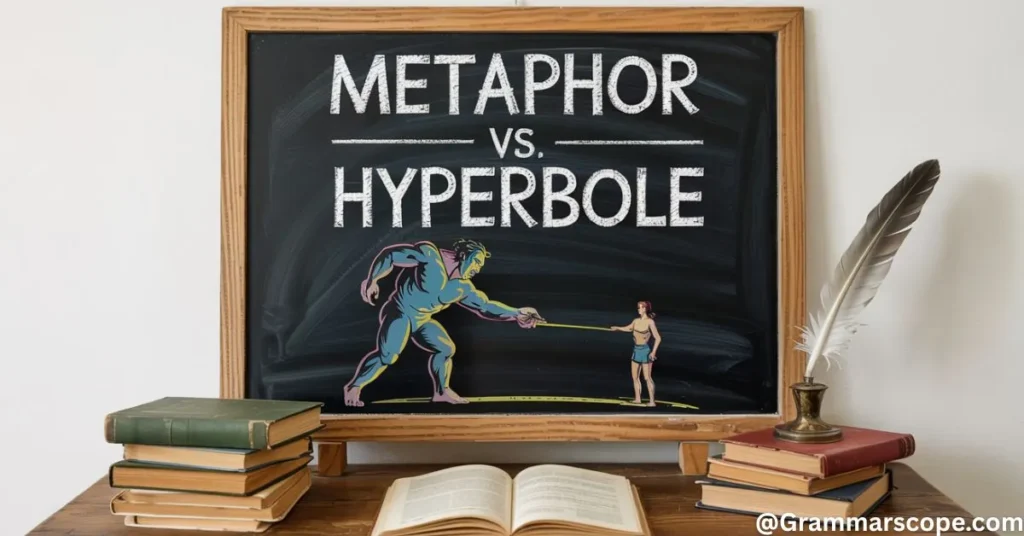Metaphor vs hyperbole creates one of the most fascinating intersections in figurative language, where comparison meets exaggeration to paint vivid pictures in our minds. When you’re trying to convey complex emotions or ideas, these powerful literary devices can transform ordinary communication into something memorable and impactful. Like master chefs selecting the perfect spices, skilled writers know exactly when to employ a subtle metaphor or when to reach for the dramatic punch of hyperbole.
Have you ever wondered why certain phrases stick with you long after you’ve heard them? It’s often because they contain these word tricks that bypass our logical brain and speak directly to our imagination. Metaphors quietly suggest “this is that” while hyperboles boldly proclaim “this is SO MUCH that it’s almost unbelievable!” Both devices color our language in ways that literal speech simply cannot achieve.
The difference between these two literary powerhouses isn’t just academic—it’s practical. Whether you’re crafting an important email, preparing a speech, or writing creative content, knowing when to compare and when to exaggerate can significantly enhance your communication. In this comprehensive guide, we’ll explore the difference between metaphor and hyperbole through clear definitions, practical examples, and situations where each shines brightest.
What is a Metaphor?

A metaphor is a figure of speech that directly compares two unrelated things by stating that one thing is another. Unlike similes that use “like” or “as,” metaphors make this comparison without these connecting words, creating a stronger, more immediate association. Metaphors work by transferring qualities from one object to describe another, helping readers understand complex concepts through familiar imagery.
Metaphors function as bridges between the known and unknown, allowing us to grasp abstract ideas through concrete comparisons. When Sarah tells her colleague, “Time is money,” she’s not suggesting that hours are literally currency, but rather emphasizing that time holds similar value and shouldn’t be wasted. This language comparison helps us comprehend abstract concepts (time) through familiar objects or ideas (money).
The beauty of metaphors lies in their ability to create instant understanding while adding depth and resonance to communication. They can transform mundane descriptions into memorable statements that engage both intellect and emotion. When a manager describes their team as “the backbone of this company,” everyone immediately understands both the function and importance being conveyed.
Examples of Metaphors in Different Contexts
In everyday conversation:
- “Mark is a rock during tough times.” (Mark = stability/strength)
- “Her voice was music to my ears.” (Voice = pleasant sound)
- “The classroom was a zoo by lunchtime.” (Classroom = wild, chaotic place)
In professional emails:
To: Marketing Team From: Jessica Reynolds Subject: Q4 Campaign Brainstorming
Team,
Our Q4 campaign needs to be a lighthouse guiding customers through the holiday shopping chaos. Last year’s approach was a sinking ship by mid-November. Let’s develop something that will be an oasis for overwhelmed shoppers.
The data from Q3 is a goldmine of insights we should leverage. I’m convinced our new loyalty program will be the cornerstone of our strategy.
Let’s meet tomorrow to discuss.
Best, Jessica
In literature:
- “All the world’s a stage, and all the people merely players.” (Shakespeare)
- “Life is a broken-winged bird that cannot fly.” (Langston Hughes)
- “Her eyes were diamonds, cutting through his defenses.” (Creative fiction)
Metaphor examples often work subtly, creating connections that feel natural while deepening our understanding. They add layers of meaning without announcing themselves, enriching language through association rather than explanation.
What is Hyperbole?

Hyperbole is deliberate and extreme exaggeration used for emphasis or humorous effect, not meant to be taken literally. Unlike metaphors that create comparisons, hyperboles amplify reality to highlight a point or evoke an emotional response. When someone says, “I’ve told you a million times,” they’re using hyperbole to emphasize frequency—not claiming mathematical accuracy.
This powerful language device serves several purposes in communication. It can express strong emotions, create humor, emphasize importance, or simply make language more colorful and engaging. Hyperboles transform ordinary statements into memorable expressions that capture attention and emphasize key points with dramatic flair.
The effectiveness of hyperbole comes from the tension between the obvious exaggeration and the underlying truth it highlights. When Madison tells her friend, “These shoes are killing me,” everyone understands she’s emphasizing discomfort, not reporting attempted murder by footwear. This intentional stretching of reality makes communication more vivid and emotionally resonant.
Examples of Hyperboles
In casual conversation:
- “I’m so hungry I could eat a horse.” (Extreme hunger)
- “This backpack weighs a ton.” (Very heavy bag)
- “We’ve been waiting for ages.” (Long but not infinite wait)
In business communication:
To: All Staff From: Daniel Chen, CEO Subject: Annual Customer Service Training
Team,
I’ve received mountains of positive feedback about last quarter’s customer service improvements. Many customers have said they’ve called hundreds of companies and none match our responsiveness.
Remember, in our industry, we’re not just competing—we need to be light years ahead of our competitors. Every customer interaction should leave them feeling like they’ve discovered customer service paradise.
The upcoming training isn’t just important—it’s absolutely critical to our continued success.
Best regards, Daniel
In marketing:
- “The sale of a lifetime!”
- “Transform your skin overnight!”
- “Our fastest processor ever—it’ll blow your mind!”
Hyperbole examples are particularly effective when they match the emotional tone of the message. A slight exaggeration in a serious context might seem dishonest, while an extreme hyperbole in casual conversation or humor can be entertaining and engaging. The key is matching the degree of exaggeration to your communication goals and audience expectations.
The Fundamental Difference Between Metaphor and Hyperbole
The difference between hyperbole and metaphor lies in their core mechanisms: metaphors create understanding through comparison, while hyperboles generate impact through exaggeration. A metaphor says “this IS that” (comparison), while hyperbole says “this is SO MUCH” (magnification). Understanding this fundamental distinction allows communicators to select the right tool for their specific purpose.
Metaphors work by transferring qualities between unrelated objects, creating new understanding through association. When a coach tells their team, “You are lions on the field,” they’re not suggesting players have manes or tails—they’re transferring qualities of power, courage, and dominance to inspire performance. The metaphor creates meaning through this conceptual mapping.
Hyperboles, conversely, take existing qualities and magnify them beyond reality for effect. When that same coach says, “We practiced this play a thousand times,” they’re emphasizing the extensive preparation—not claiming to have literally completed that many repetitions. The hyperbole creates emphasis through deliberate overstatement of what’s already there.
Comparing Their Functions
| Aspect | Metaphor | Hyperbole |
|---|---|---|
| Core Function | Creates comparison | Creates exaggeration |
| Reality Relationship | Suggests a new perspective | Stretches existing reality |
| Cognitive Effect | Enhances understanding | Enhances emotional impact |
| Typical Purpose | Clarification, depth | Emphasis, drama |
| When Overused | Can become confusing | Can seem dishonest |
Both devices can work together effectively. Consider this example: “Her rejection was a dagger that left me bleeding for months.” Here, the metaphor (rejection = dagger) combines with hyperbole (bleeding for months) to communicate both the nature and intensity of emotional pain in a way literal language cannot.
When to Use Metaphor vs Hyperbole

Knowing when to use metaphors versus when to use hyperbole can significantly enhance your communication effectiveness. Each device has ideal applications where it shines brightest, and understanding these contexts helps you make writing interesting with purpose rather than just stylistic flair.
When Metaphors Work Best
Use metaphors when:
- Explaining complex concepts: Metaphors bridge unfamiliar ideas with familiar ones.
- Adding emotional depth: They create richer associations than literal descriptions.
- Creating lasting imagery: Metaphors tend to stick in memory longer than direct statements.
- Needing subtlety: They allow indirect communication of sensitive topics.
Example scenario – Technical explanation email:
To: New clients From: Emma Watts Subject: Understanding Your Cloud Storage
Dear Valued Client,
Think of your new cloud storage system as a digital safety deposit box that’s accessible from anywhere. Your data isn’t just stored—it’s wrapped in layers of encryption that function as virtual vault doors.
The dashboard is your control center where you can manage all aspects of your storage. The automated backup system works like a diligent librarian, constantly organizing and preserving your important files.
Please reach out with any questions as you explore your new digital ecosystem.
Best regards, Emma
When Hyperbole Works Best
Use hyperbole when:
- Emphasizing importance: Exaggeration highlights significance.
- Creating humor: Obvious overstatement often generates laughs.
- Expressing strong emotion: Hyperbole matches intensity of feelings.
- Grabbing attention: Dramatic statements capture interest quickly.
Example scenario – Motivational team email:
To: Sales Team From: Marcus Johnson Subject: Last Push for Q4 Targets
Team,
We’re in the final countdown of what feels like the longest quarter in history! Our competitors would give their right arms for the opportunity we have in these last two weeks.
I’ve seen everyone working around the clock to close these deals, and your dedication is nothing short of miraculous. We’re just a hair’s breadth away from breaking every record in company history!
Let’s make these final days count with unstoppable energy!
Marcus
How to Master Both Literary Devices
Learning to effectively incorporate both metaphors and hyperboles into your communication requires practice and attention to several key writing tips. Mastering these language devices will significantly enhance your ability to engage readers, clarify complex ideas, and add memorable flair to your writing.
Tips for Crafting Effective Metaphors
- Start with the quality you want to convey: Before creating a metaphor, identify exactly what characteristic you want to highlight.
- Choose familiar comparison objects: Select things your audience easily understands as your metaphorical vehicles.
- Test for coherence: Make sure your metaphor makes logical sense in transferring the qualities you intend.
- Avoid cliché expressions: “Busy as a bee” or “cold as ice” lack impact because they’re overused. Create fresh comparisons.
- Extend thoughtfully: Extended metaphors can be powerful, but don’t stretch them beyond their natural limits.
Pro tip: When crafting metaphors for professional communication, choose comparison objects relevant to your industry or audience’s interests. This creates both understanding and connection.
Tips for Creating Impactful Hyperbole
- Match exaggeration to context: A slight exaggeration might work in formal settings, while extreme overstatement fits casual or humorous situations.
- Ensure obvious unreality: Effective hyperbole should be clearly recognizable as exaggeration, not potential misinformation.
- Focus on emotion: The best hyperboles capture and express emotional intensity.
- Use sparingly in serious contexts: Too many exaggerations can damage credibility in formal settings.
- Balance with straightforward language: Surrounding hyperbole with clear, direct statements enhances its impact through contrast.
Pro tip: The most effective use of hyperbole vs metaphor often comes from knowing when to combine them. Consider this example: “The project deadline is approaching at lightning speed (metaphor), and we’ve got a mountain of work that would take normal teams decades to complete (hyperbole).”
Common Mistakes to Avoid
Even experienced writers sometimes struggle with the proper application of figurative language. Being aware of these potential pitfalls will help you use these stylistic elements more effectively.
Metaphor Pitfalls
- Mixed metaphors: Combining incompatible metaphors creates confusion rather than clarity. “Let’s tackle this issue head-on before it snowballs out of control” mixes sports and weather metaphors awkwardly.
- Clichéd expressions: Overused metaphors like “thinking outside the box” have lost impact through repetition.
- Overly complex comparisons: If your audience needs to work too hard to understand the relationship, the metaphor fails.
- Cultural mismatches: Metaphors often depend on cultural knowledge—ensure your comparisons translate across your audience.
Hyperbole Hazards
- Credibility damage: Excessive exaggeration in serious contexts can make you seem untrustworthy.
- Numbing effect: Constant hyperbole creates diminishing returns—save it for when impact is truly needed.
- Misinterpretation: Sometimes hyperbole can be mistaken for literal claims, especially in written communication without tone indicators.
- Inappropriate contexts: Hyperbole in sensitive situations (medical information, legal contexts, etc.) can create serious misunderstandings.
Real-World Applications
Understanding the difference between metaphor and hyperbole becomes truly valuable when applied to everyday communication scenarios. Here’s how these devices can enhance various types of real-world writing.
In Marketing Copy
Marketers regularly employ both devices, with metaphors creating brand identity and emotional connection, while hyperboles generate excitement and urgency. Consider this product description:
The new UltraFocus headphones aren’t just noise-canceling—they’re your personal sanctuary in a chaotic world (metaphor). With absolutely revolutionary sound technology that blocks every whisper of distraction (hyperbole), these headphones transform your listening experience into a journey of discovery (metaphor) that will blow everything else out of the water (hyperbole).
In Professional Emails
Even in business contexts, judicious use of these devices can enliven communication:
To: Project Team From: Sophia Williams Subject: Q2 Report Feedback
Team,
The Q2 report is a masterpiece that tells our company’s story with remarkable clarity. The data visualization section is particularly impressive—those graphs are windows into our performance that even non-technical stakeholders can understand instantly.
I’ve reviewed countless reports over my career, and this stands among the very best. The executive team spent forever analyzing your findings, which is testament to their value.
Let’s schedule time to discuss how this blueprint can guide our Q3 strategy.
Regards, Sophia
In Educational Content
Teachers can leverage these devices to make complex information more accessible and memorable:
The water cycle isn’t just a process—it’s Earth’s recycling system (metaphor) that has been working tirelessly for billions of years (hyperbole). The atmosphere acts as a giant sponge (metaphor) that can hold astronomical amounts of moisture (hyperbole) before releasing it back to the surface.
Enhancing Your Writing with Both Devices

The most skilled communicators know that figurative expressions often work best in combination. Learning to weave metaphors and hyperboles together creates writing that’s both intellectually engaging and emotionally impactful. Here are strategies for combining these language devices effectively:
- Use metaphors for framework, hyperbole for emphasis: Establish understanding with metaphor, then amplify importance with hyperbole.
- Create contrast through alternation: Following a subtle metaphor with dramatic hyperbole creates memorable rhythm in writing.
- Match devices to content complexity: Use metaphors for complex ideas and hyperbole for emotional resonance.
- Consider audience sophistication: More educated audiences often appreciate nuanced metaphors, while general audiences respond well to clear hyperbole.
- Maintain consistent tone: Ensure your figurative language matches your overall communication style.
Frequently Asked Question
What is the difference between hyperbole and metaphor?
The difference between hyperbole and metaphor lies in their core mechanisms:
A metaphor creates understanding through comparison, stating that one thing IS another thing (even though they’re literally different). It transfers qualities between unrelated objects to create new understanding. Example: “Her smile is sunshine” compares a smile to sunshine to convey warmth and brightness.
Hyperbole creates impact through deliberate exaggeration, magnifying reality beyond what’s literally possible for emphasis or effect. It stretches existing qualities to an extreme degree. Example: “I’ve told you a million times” emphasizes frequency through obvious overstatement.
Simply put: metaphors compare (“this IS that”) while hyperboles exaggerate (“this is SO MUCH”).Retry
Is it’s raining cats and dogs a metaphor or hyperbole?
“It’s raining cats and dogs” is a hyperbole, not a metaphor.
It’s a hyperbole because it exaggerates the intensity of the rain by suggesting something impossible (animals falling from the sky) to emphasize how heavy the rainfall is. The phrase doesn’t compare rain to cats and dogs (which would make it a metaphor); instead, it uses an obvious overstatement to convey the extreme nature of the downpour.
The expression deliberately stretches reality beyond what’s literally possible to emphasize the rain’s intensity, which is the defining characteristic of hyperbole.
What is the difference between a metaphor and a hyperbolic?
The difference between a metaphor and hyperbole is in how they function:
A metaphor directly compares two unlike things by saying one thing IS another thing. Example: “Time is a thief” (comparing time to a person who steals).
Hyperbole uses extreme exaggeration for emphasis or effect, not meant to be taken literally. Example: “I’m so hungry I could eat a horse” (exaggerating hunger).
In essence, metaphors create meaning through comparison while hyperbole creates impact through deliberate overstatement. Metaphors say “this IS that” while hyperboles say “this is SO MUCH.”
Is exaggeration a metaphor or hyperbole?
Exaggeration is hyperbole, not metaphor.
Hyperbole is defined by intentional exaggeration used for emphasis or effect. When you deliberately overstate something beyond what’s literally possible or reasonable, you’re using hyperbole.
Metaphor, on the other hand, is about comparing two unlike things by stating one is the other, without using “like” or “as.” It creates understanding through comparison rather than exaggeration.
So when someone says “This bag weighs a ton” (when it doesn’t literally weigh 2,000 pounds), they’re using hyperbole – deliberate exaggeration to emphasize heaviness.
What is an example of a hyperbole?
An example of a hyperbole is “I’m so hungry I could eat a horse.”
This statement contains obvious, deliberate exaggeration – no person could literally consume an entire horse in one sitting. The extreme overstatement is used to emphasize just how intense the person’s hunger feels, not to make a literal claim.
Other hyperbole examples include:
- “This backpack weighs a ton”
- “I’ve told you a million times”
- “I’m dying of embarrassment”
- “She’s older than the hills”
In each case, the exaggeration creates emphasis through obvious overstatement that isn’t meant to be taken literally.
Conclusion
The journey through metaphor vs hyperbole reveals how these powerful language devices serve as essential tools in the writer’s toolkit. Metaphors create understanding through comparison, allowing us to comprehend the unfamiliar through the familiar. Hyperboles generate emphasis through exaggeration, helping us convey emotional intensity and importance beyond what literal language allows.
The difference between hyperbole and metaphor isn’t just academic—it’s practical. Knowing when to compare and when to exaggerate enables communicators to craft messages with precision and impact. Like a chef selecting between salt and spice, the skilled writer chooses between metaphor and hyperbole based on the specific flavor they wish to impart to their words.
As you continue developing your writing skills, experiment with both devices across different contexts. Notice how metaphors can transform abstract concepts into concrete understanding, while hyperboles can elevate emotional resonance to new heights. With practice and attention to these stylistic elements, your communication will gain both clarity and impact—becoming not just functional, but truly memorable.

Emma Olivia is an experienced blogger and the creative mind behind Grammar Scope. With a passion for language and years of writing expertise, she crafts engaging, informative content that simplifies grammar and writing tips for readers worldwide. Emma’s dedication to clear communication and love for the written word shine through every article she publishes, making Grammar Scope a trusted resource for language enthusiasts and learners alike.






